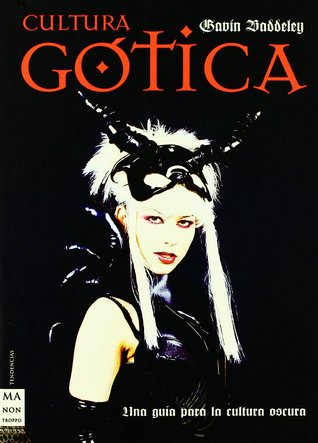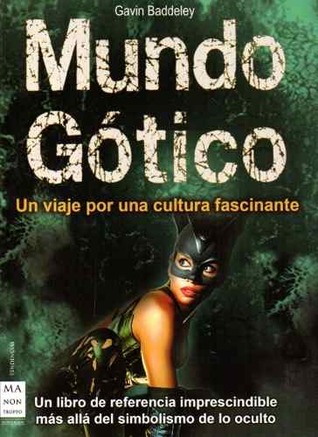 |
| Fuente / Source |
¡Hola, Nocturnos! Tengo un tiempo ya sin escribir una entrada que no sea sobre libros o reseñas, así que decidí rescatar un tema que ya había tocado y darle el trato que merece: ¿A qué nos referimos todos cuando decimos que somos góticos? ¿De qué se trata esta subcultura y de dónde viene?
En cuanto a la primera pregunta, gótico cambia ligeramente dependiendo de a quién se le pregunte, aunque hay ciertas ideas que se mantienen sin importar la respuesta, principalmente el interés por lo oscuro y alternativo.
Los góticos nos interesamos por todo aquello que sea oscuro, morboso, extraño, y entedemos cuestiones simples o complejas a través de métodos poco ortodoxos. Me pondré como ejemplo de esto: para entender mi realidad, lo hago a través de la fantasía oscura.
Sin embargo, la subcultura gótica no es solo entender, sino también sentir, percibir. Los góticos somos sensibles antes que nada. Tenemos una visión particular que nos permite encontrar la belleza en lo oscuro, en lo macabro, en los miedos que tenemos, y disfrutar de ello. Los góticos aceptamos que hay sombras mientras que haya luz, y que habrá mal mientras exista el bien, y sabemos que esto está bien.
Contrario a lo que muchos piensan, ser parte de la subcultura gótica no significa estar triste, vestirse de negro y sentirse miserable todo el tiempo. La estética oscura es solo una parte del movimiento, y hay personas con vestimentas llamativas, otros más sencillos, pero la estética no significa credibilidad, sin contar que también tenemos sentimientos como cualquier otra persona.
Hay algunos que piensan que para pertenecer a la subcultura solo hay gustar del rock gótico. La idea, aunque válida, se queda corta. El género musical vino mucho después de que la palabra apareciera por primera vez, y desde entonces han aparecido infinidad de sub géneros y derivados: metal gótico, darkwave, dark electro, deathrock, gothabilly, ethereal wave, horror punk, nu goth...
Ahora, en cuanto a la historia, de dónde vino todo este movimiento, les dejo dos videos bastante sencilos y que explican muy bien la historia de la subcultura gótica, junto con otro de Jillian Venters sobre de qué trata esta subcultura. ¡Espero que les gusten!
Hello, Nighters! I have a time without writing an entry that's not about books or reviews, so I decided to rescue a topic I had already touched and give it the treatment it deserves: What do we all mean when we say that we are Goths? What is this subculture about and where does it come from?
Regarding the first question, Gothic changes slightly depending on who you ask, although there are certain ideas that remain regardless of the answer, mainly the interest in the dark and alternative.
We Goths are interested in everything that is dark, morbid, strange, and we understand simple or complex issues through unorthodox methods. I will put myself as an example of this: to understand my reality, I do it through dark fantasy.
However, the Gothic subculture is not only to understand, but also to feel, to perceive. We Goths are sensible first of all. We have a particular vision that allows us to find beauty in darkness, in the macabre, in the fears we have, and enjoy it. We Goths accept that there are shadows while there is light, and that there will be evil while there is good, and we know that this is fine.
Contrary to what many people think, being part of the Gothic subculture doesn't mean being sad, dressing in black and feeling miserable all the time. Dark aesthetics is only part of the movement, and there are people with flashy clothes, others simpler, but aesthetics doesn't mean credibility, not to mention that we also have feelings like any other person.
There are some who think that to belong to the subculture you just have to like gothic rock. The idea, although valid, falls short. The musical genre came long after the word appeared for the first time, and since then, countless sub genres and derivatives have appeared: gothic metal, darkwave, dark electro, deathrock, gothabilly, ethereal wave, horror punk, nu goth...
Now, in terms of history, where this movement came from, I leave you with two very simple videos that explain the history of the Gothic subculture very well, together with another one by Jillian Venters about what this subculture is about. I hope you like them!
En cuanto a la primera pregunta, gótico cambia ligeramente dependiendo de a quién se le pregunte, aunque hay ciertas ideas que se mantienen sin importar la respuesta, principalmente el interés por lo oscuro y alternativo.
 |
| "Los góticos somos sensibles antes que nada". Fuente / Source. |
Sin embargo, la subcultura gótica no es solo entender, sino también sentir, percibir. Los góticos somos sensibles antes que nada. Tenemos una visión particular que nos permite encontrar la belleza en lo oscuro, en lo macabro, en los miedos que tenemos, y disfrutar de ello. Los góticos aceptamos que hay sombras mientras que haya luz, y que habrá mal mientras exista el bien, y sabemos que esto está bien.
Contrario a lo que muchos piensan, ser parte de la subcultura gótica no significa estar triste, vestirse de negro y sentirse miserable todo el tiempo. La estética oscura es solo una parte del movimiento, y hay personas con vestimentas llamativas, otros más sencillos, pero la estética no significa credibilidad, sin contar que también tenemos sentimientos como cualquier otra persona.
Hay algunos que piensan que para pertenecer a la subcultura solo hay gustar del rock gótico. La idea, aunque válida, se queda corta. El género musical vino mucho después de que la palabra apareciera por primera vez, y desde entonces han aparecido infinidad de sub géneros y derivados: metal gótico, darkwave, dark electro, deathrock, gothabilly, ethereal wave, horror punk, nu goth...
Ahora, en cuanto a la historia, de dónde vino todo este movimiento, les dejo dos videos bastante sencilos y que explican muy bien la historia de la subcultura gótica, junto con otro de Jillian Venters sobre de qué trata esta subcultura. ¡Espero que les gusten!
Hello, Nighters! I have a time without writing an entry that's not about books or reviews, so I decided to rescue a topic I had already touched and give it the treatment it deserves: What do we all mean when we say that we are Goths? What is this subculture about and where does it come from?
 |
| "We Goths are sensible first of all". Fuente / Source |
We Goths are interested in everything that is dark, morbid, strange, and we understand simple or complex issues through unorthodox methods. I will put myself as an example of this: to understand my reality, I do it through dark fantasy.
However, the Gothic subculture is not only to understand, but also to feel, to perceive. We Goths are sensible first of all. We have a particular vision that allows us to find beauty in darkness, in the macabre, in the fears we have, and enjoy it. We Goths accept that there are shadows while there is light, and that there will be evil while there is good, and we know that this is fine.
Contrary to what many people think, being part of the Gothic subculture doesn't mean being sad, dressing in black and feeling miserable all the time. Dark aesthetics is only part of the movement, and there are people with flashy clothes, others simpler, but aesthetics doesn't mean credibility, not to mention that we also have feelings like any other person.
There are some who think that to belong to the subculture you just have to like gothic rock. The idea, although valid, falls short. The musical genre came long after the word appeared for the first time, and since then, countless sub genres and derivatives have appeared: gothic metal, darkwave, dark electro, deathrock, gothabilly, ethereal wave, horror punk, nu goth...
Now, in terms of history, where this movement came from, I leave you with two very simple videos that explain the history of the Gothic subculture very well, together with another one by Jillian Venters about what this subculture is about. I hope you like them!












No hay comentarios.:
Publicar un comentario